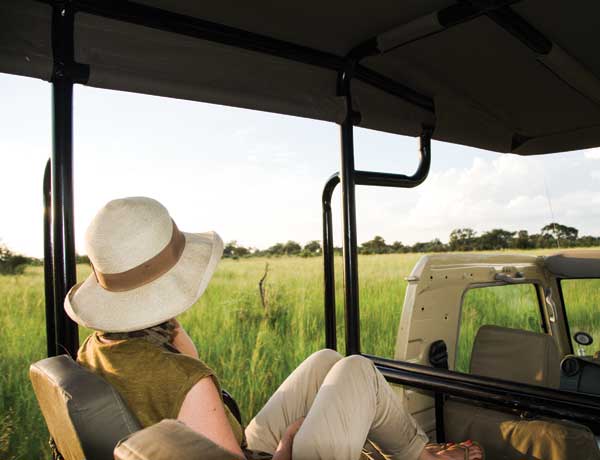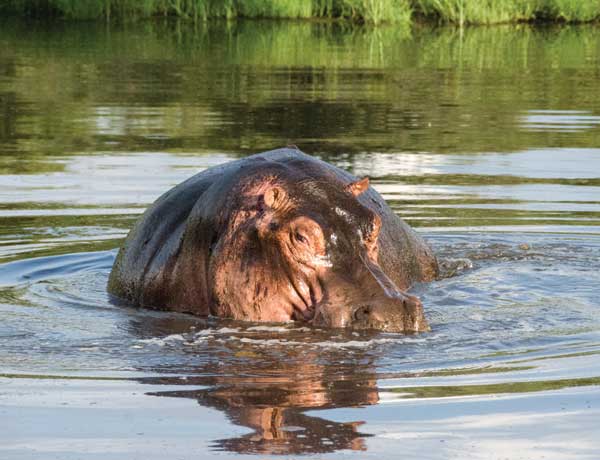
The history of the Namibia Tourism Expo
May 20, 2016
Top campsites inside Namibia’s parks
May 25, 2016Dreaming in the treetops…
Text and Photographs Elzanne Erasmus | Main photo ©Timo De Nijs
Elephants amble through the trees
A lark chants in the background
Baboons sit dreaming in the canopies
A hamerkop flies south
The stately animals make their way through the marshes. Slowly but surely they navigate the wet ground underfoot. Among them, barely sticking out above the tall grasses, you can make out the backs of young calves. They weave their way through their mothers’ legs. Hiding from the big world they haven’t quite gotten a grasp on yet. We are treading the off-road track that leads from the entrance gate of Bwabwata National Park to Nambwa Tented Lodge, when a herd of about 50 elephants cross our path. We wait patiently as they pass, one by one, the sound of twigs and branches crushing underfoot as they make their way to the Kwando River not too far away.
In 2007 the former Caprivi Game Park, proclaimed in 1966, was incorporated into the 6 100 km2 Bwabwata National Park, together with the Kwando – or Golden Triangle – and the Buffalo and Mahango (the former Mahango Game Park) core areas. The park is a sanctuary for 35 large game species – including elephant, buffalo, impala, reedbuck, red lechwe, sitatunga, hippo, giraffe, zebra, wildebeest, Chobe bushbuck, tsessebe, sable and roan antelope – and numerous small game species. Predators such as lion, leopard, cheetah and African wild dog can also be found in the park. Most of these species congregate along the Okavango and Kwando riverbanks and at the Malombe and Ndwasa pans in the northeast. The Okavango and Kwando rivers and their respective floodplains are important habitats for wetland bird species such as wattled cranes and African skimmers. Over 400 bird species have been recorded here. Crocodiles and hippo flourish in the rivers, so beware. Bwabwata takes its name, which refers to the sound of bubbling water, from a village in the park. It forms part of the 278 132 km2 Kavango-Zambezi (KAZA) Transfrontier Conservation Area, the world’s largest conservation area.
Nambwa Tented Lodge, on the Kwando River, is the only lodge inside Bwabwata National Park. The spacious tented suites are connected with walkways raised high enough for elephants to pass underneath, honouring their right of way. Upon arrival at the lodge we were met by managers Juan and Bertha and our guide for the duration of our stay, Beaven. Welcome drinks and excited conversation quickly ensued and we set off to explore this unique location.
As you make your way across the wooden walkways it feels as if you have stumbled through a wormhole into a tropical rainforest. The overwhelming green, the clean fresh scents and the sounds of birds chatting a mile a minute… This is not Namibia as we know it. It’s another form of paradise
Early in the morning, we were woken by the soft thuds of movement on the boardwalks. It was Chef Lasken bringing us coffee in bed. Three kudu cows strolled across the floodplain that the lodge’s main viewing deck overlooks. I sipped my coffee as I gazed at the beautiful ladies making their way through the early morning mist, but there wasn’t too much time to lounge around – there’s a river to explore! Soon we were scooted along to where a boat was docked on the riverbank. The tuk-tuk-tuk of the engine and the soft lapping of water were the only sounds as we slowly made our way down the Kwando. The river was a bevvy of aviary activity and our bird-loving hearts fluttered with excitement. Beaven’s eagle eyes spotted and identified birds left and right before we could even think to ask. We spent the morning ticking off one lifer after the other. Who needs a Roberts’ when there is a Beaven on board?
Our next Nambwa adventure took place on dry land and four wheels. Zambezi teak and knob thorn dotted the bushland. Beaven pointed out and named the trees as we drove along the tracks following the tributaries of the Kwando River. We spent two hours driving through the beautiful green shades of the park, spotting kudu, lechwe and impala grazing or darting through the bush. In a shallow pond along one of the Kwando floodplains a lone hippo bull lazed away in the water, enjoying full access to his own private mud bath. Giraffe moved alongside our game-viewer as we made our way toward one of the most popular attractions in the area, Horseshoe Lagoon. Here, the Kwando River does an about-turn as if it has all of a sudden changed its mind about its final destination.
As we approached the Horseshoe “beachfront” we were met with a very welcome sight. A sundowner surprise, complete with bonfire, camping chairs in a semicircle, a snack bar and the all-important Gin & Tonic station, was set up on the riverbank. The dramatic sunset, made even more spectacular by the storm clouds overhead, was a perfect backdrop. We enjoyed soup and delectable snacks as we sipped our sundowners, chatting away around the fire. Hippos called in the distance, their iconic grunts complimenting the aesthetics of this unforgettable experience. Upon our return to the lodge that evening our baths were drawn and decorated with flower petals. Never before had I felt quite so spoiled as we indulged in the lavishness of it all.
Sitting around the dinner table that evening, sated after a wonderful meal, we absorbed the atmosphere of this magical place. According to our hosts, Dusty and Tinolla, the word ‘Nambwa’ does not have any specific meaning. I feel that it should, though. It deserves a wonderful description or a romantic story to surround it as nature surrounds the lodge itself. Maybe we’ll make one up… Nambwa: where elephants roam. Nambwa: the place of dreams. Nambwa: paradise on the river. Reveries aside, it was time to say ‘good night’, or Rareni po nawa, and return to our tree houses, where we listened to the soft coos of the nightjars until we drifted off to a peaceful sleep filled with African dreams.
When you’ve acquired a taste for dust,
The scent of our first rain,
You’re hooked for life on Africa
and you’ll not be right again.
– From ‘Africa’ by Emily Debb









OUR NAMBWA TENTED LODGE BIRDING CHECKLIST:
We spotted these birds on our recent trip:
❏ African Stone Chat
❏ African Skimmer
❏ Pied Kingfisher
❏ Wattled Cranes
❏ Orange-breasted Bushshrike
❏ Water Thick-knee
❏ Green Pigeon
❏ Blue-cheeked Bee-eater
❏ Swainson’s Francolin
❏ Village Weaver
❏ Yellow-billed Oxpecker
❏ White-faced ducks
❏ Carmine Bee-eater
❏ Banded Martin
❏ Hamerkop
❏ Egyptian Geese
❏ Goliath Heron
❏ Osprey
❏ Fish Eagle
This article was first published in the Winter 2016 issue of Travel News Namibia.


